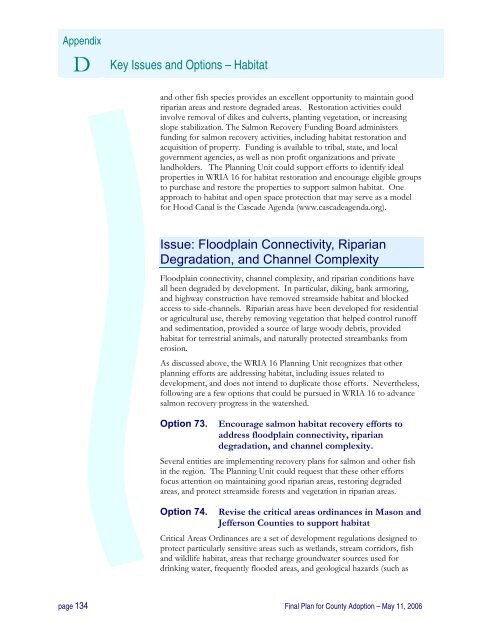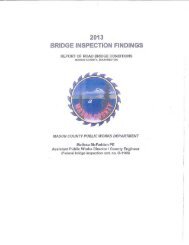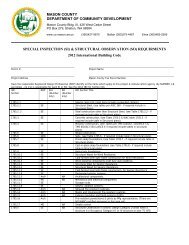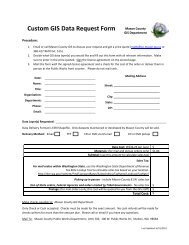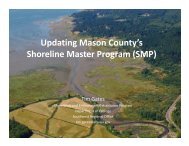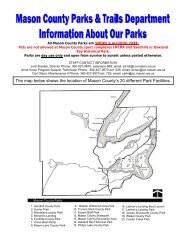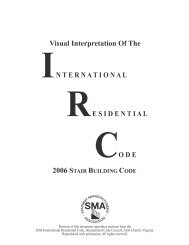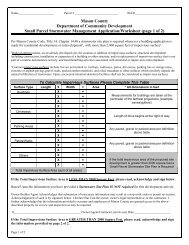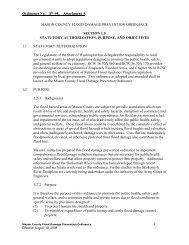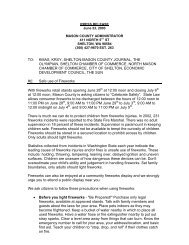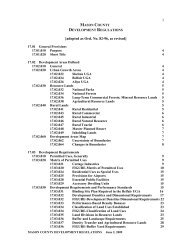Watershed Management Plan - Mason County
Watershed Management Plan - Mason County
Watershed Management Plan - Mason County
Create successful ePaper yourself
Turn your PDF publications into a flip-book with our unique Google optimized e-Paper software.
Appendix<br />
D Key Issues and Options – Habitat<br />
and other fish species provides an excellent opportunity to maintain good<br />
riparian areas and restore degraded areas. Restoration activities could<br />
involve removal of dikes and culverts, planting vegetation, or increasing<br />
slope stabilization. The Salmon Recovery Funding Board administers<br />
funding for salmon recovery activities, including habitat restoration and<br />
acquisition of property. Funding is available to tribal, state, and local<br />
government agencies, as well as non profit organizations and private<br />
landholders. The <strong>Plan</strong>ning Unit could support efforts to identify ideal<br />
properties in WRIA 16 for habitat restoration and encourage eligible groups<br />
to purchase and restore the properties to support salmon habitat. One<br />
approach to habitat and open space protection that may serve as a model<br />
for Hood Canal is the Cascade Agenda (www.cascadeagenda.org).<br />
Issue: Floodplain Connectivity, Riparian<br />
Degradation, and Channel Complexity<br />
Floodplain connectivity, channel complexity, and riparian conditions have<br />
all been degraded by development. In particular, diking, bank armoring,<br />
and highway construction have removed streamside habitat and blocked<br />
access to side-channels. Riparian areas have been developed for residential<br />
or agricultural use, thereby removing vegetation that helped control runoff<br />
and sedimentation, provided a source of large woody debris, provided<br />
habitat for terrestrial animals, and naturally protected streambanks from<br />
erosion.<br />
As discussed above, the WRIA 16 <strong>Plan</strong>ning Unit recognizes that other<br />
planning efforts are addressing habitat, including issues related to<br />
development, and does not intend to duplicate those efforts. Nevertheless,<br />
following are a few options that could be pursued in WRIA 16 to advance<br />
salmon recovery progress in the watershed.<br />
Option 73.<br />
Encourage salmon habitat recovery efforts to<br />
address floodplain connectivity, riparian<br />
degradation, and channel complexity.<br />
Several entities are implementing recovery plans for salmon and other fish<br />
in the region. The <strong>Plan</strong>ning Unit could request that these other efforts<br />
focus attention on maintaining good riparian areas, restoring degraded<br />
areas, and protect streamside forests and vegetation in riparian areas.<br />
Option 74.<br />
Revise the critical areas ordinances in <strong>Mason</strong> and<br />
Jefferson Counties to support habitat<br />
Critical Areas Ordinances are a set of development regulations designed to<br />
protect particularly sensitive areas such as wetlands, stream corridors, fish<br />
and wildlife habitat, areas that recharge groundwater sources used for<br />
drinking water, frequently flooded areas, and geological hazards (such as<br />
page 134 Final <strong>Plan</strong> for <strong>County</strong> Adoption – May 11, 2006


